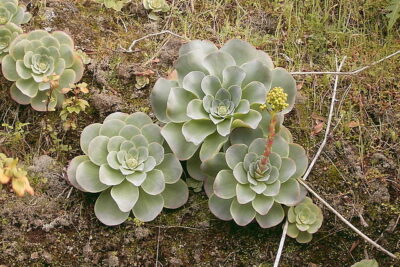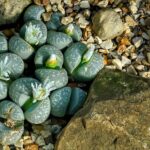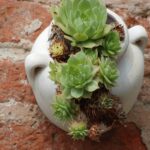
Growing Trunked Succulents Indoors: A Guide

Trunked succulents are a fascinating and unique category of plants that can add a touch of exotic beauty to any indoor space. Unlike most succulents, which typically have small, compact forms, trunked succulents have a woody stem or trunk that can grow tall and develop an impressive presence. These plants are not only aesthetically appealing but also relatively low-maintenance, making them a popular choice for indoor gardening enthusiasts.
We will explore the world of growing trunked succulents indoors and provide you with a comprehensive guide on how to care for these plants. We will discuss the different types of trunked succulents available, their specific care requirements, and the best practices for creating an optimal indoor environment for their growth. Additionally, we will cover topics such as potting and repotting, watering and fertilizing, as well as common issues and troubleshooting tips. By the end of this article, you will have all the knowledge you need to successfully cultivate and enjoy these stunning plants in your own home.
- Choose succulents with a naturally long and sturdy trunk
- Provide ample sunlight by placing them near a south-facing window
- Use a well-draining soil mix specifically designed for succulents
- Water sparingly, allowing the soil to dry out completely between waterings
- Rotate the succulents every few weeks to ensure even growth
- Consider using grow lights to supplement natural sunlight
- Prune the succulents regularly to maintain their desired shape and size
- Fertilize with a balanced succulent fertilizer during the growing season
- Protect the succulents from extreme temperatures and drafts
- Monitor for pests and take appropriate action if necessary
- Enjoy the unique beauty and growth of your trunked succulents indoors
- Frequently Asked Questions
Choose succulents with a naturally long and sturdy trunk
When it comes to growing trunked succulents indoors, it is important to choose varieties that have a naturally long and sturdy trunk. This is because the trunk plays a vital role in providing support to the plant and ensuring its overall health and stability.
One of the popular succulent varieties that have a naturally long and sturdy trunk is the Beaucarnea recurvata, also known as the Ponytail Palm. This succulent features a thick, swollen trunk that tapers as it reaches upward, giving it a unique and attractive appearance.
Another succulent with a well-developed trunk is the Adenium obesum, commonly known as the Desert Rose. This succulent grows a thick, woody trunk that can reach several feet in height. The trunk of the Desert Rose not only provides support but also stores water, allowing the plant to survive in arid conditions.
When selecting trunked succulents for indoor cultivation, it is essential to consider their growth habits as well as the available space in your home. Some succulents, like the Ponytail Palm, can grow quite tall, requiring enough vertical space to accommodate their growth. On the other hand, smaller varieties like the Desert Rose are more suitable for limited space.
 Choosing Low-Light Succulents: A Guide to Thriving Indoors
Choosing Low-Light Succulents: A Guide to Thriving IndoorsEnsure that the succulent's trunk is healthy and free from any signs of damage or rot. A healthy trunk should feel firm to the touch and exhibit no soft spots or discoloration. Additionally, inspect the base of the trunk for any signs of pests or diseases, as these can affect the overall health of the plant.
Proper care and maintenance are crucial for promoting trunk growth in succulents. Provide your succulents with adequate sunlight, ideally placing them near a south-facing window or using grow lights if natural light is limited. Water your succulents sparingly, allowing the soil to dry out between watering sessions to prevent root rot.
Selecting succulents with naturally long and sturdy trunks is essential for successful indoor cultivation. Consider the growth habits and available space, ensure the trunk is healthy, and provide proper care to promote trunk growth. By following these guidelines, you can enjoy the beauty of trunked succulents in your indoor space.
Provide ample sunlight by placing them near a south-facing window
When it comes to growing trunked succulents indoors, one of the most important factors to consider is providing ample sunlight. These plants thrive in bright light and need at least six hours of direct sunlight each day. To ensure they receive enough light, it is recommended to place them near a south-facing window.
A south-facing window typically receives the most sunlight throughout the day, making it an ideal spot for your trunked succulents. Positioning them close to the window will allow them to soak up the sunlight they need to grow and thrive.
However, it is important to note that even though succulents love sunlight, they can still get sunburned if exposed to too much direct sunlight. If you notice signs of sunburn, such as discoloration or brown spots on the leaves, consider moving your plants slightly away from the window or providing some shade during the hottest hours of the day.
Overall, ensuring your trunked succulents receive ample sunlight is crucial for their growth and overall health. So, make sure to find the perfect spot near a south-facing window to help them flourish.
 Growing Aloe Vera Indoors: Tips for Cultivating Succulent Houseplants
Growing Aloe Vera Indoors: Tips for Cultivating Succulent HouseplantsUse a well-draining soil mix specifically designed for succulents
When growing trunked succulents indoors, it is crucial to use a well-draining soil mix specifically designed for succulents. Succulents, including those with a trunk-like structure, have unique watering requirements due to their ability to store water in their leaves and stems. A well-draining soil mix ensures that excess water can easily escape, preventing the roots from sitting in water and potentially rotting.
It is recommended to use a combination of materials to create the perfect soil mix for trunked succulents. One popular recipe includes equal parts of potting soil, perlite, and coarse sand. The potting soil provides the necessary nutrients, while perlite and coarse sand enhance drainage and aeration.
When selecting a pot for your trunked succulent, opt for one with drainage holes at the bottom. This allows excess water to flow out freely, further preventing waterlogged roots. Additionally, using a pot with a slightly larger size than the plant's root ball allows for proper root growth and development.
Provide ample sunlight for healthy growth
Succulents thrive in bright, indirect sunlight. When growing trunked succulents indoors, it is essential to provide them with ample sunlight to promote healthy growth. Place your succulent near a south-facing window where it can receive several hours of sunlight each day.
If your indoor environment does not receive enough natural sunlight, you can supplement it with artificial grow lights. LED grow lights are a popular choice among indoor gardeners as they emit the right spectrum of light for succulent growth. Position the grow lights a few inches above the succulent to mimic the intensity of natural sunlight.
Water your trunked succulents sparingly
One common mistake when caring for trunked succulents is overwatering. These plants have adapted to survive in arid conditions and are more likely to suffer from too much water than too little. Water your trunked succulents sparingly, allowing the soil to dry out partially between waterings.
A general rule of thumb is to water your succulent only when the top inch of soil feels dry to the touch. Use a watering can or a narrow-spouted container to direct the water directly to the soil, avoiding the leaves and trunk. Ensure that excess water drains out of the pot completely.
 Can You Successfully Grow Lotus Lithops Succulents Indoors?
Can You Successfully Grow Lotus Lithops Succulents Indoors?During the winter months, when succulents enter a period of dormancy, reduce the frequency of watering even further. The reduced light levels and cooler temperatures slow down the plant's growth and water requirements.
- Tip: Succulents are more tolerant of underwatering than overwatering. If in doubt, it's better to underwater than overwater your trunked succulents.
By following these guidelines for growing trunked succulents indoors, you can create a favorable environment for their growth and enjoy the unique beauty they bring to your indoor space.
Water sparingly, allowing the soil to dry out completely between waterings
When it comes to growing trunked succulents indoors, proper watering is key. These unique plants have adapted to survive in arid environments, so they have a natural ability to store water in their thick, fleshy leaves and stems. Overwatering can quickly lead to root rot and other issues, so it's important to water sparingly.
One of the most common mistakes that succulent owners make is overwatering. These plants thrive in well-draining soil, so it's crucial to allow the soil to dry out completely between waterings. Before watering your trunked succulents, always check the moisture level of the soil. Stick your finger about an inch into the soil - if it feels dry, it's time to water.
When watering, make sure to do so thoroughly. Give your succulents a good soak until water drains out of the bottom of the pot. This ensures that the entire root system receives moisture, promoting healthy growth. However, avoid letting your succulents sit in standing water as this can lead to root rot. Always empty the drainage tray after watering.
It's important to note that the frequency of watering will depend on various factors such as the size of the pot, the type of succulent, and the environmental conditions. As a general rule of thumb, water your trunked succulents every 1-2 weeks during the growing season, and reduce watering frequency during the dormant period.
 Can You Keep Succulents Indoors Year-Round?
Can You Keep Succulents Indoors Year-Round?Remember, it's always better to underwater than to overwater your trunked succulents. These plants are adapted to survive in harsh conditions, and they can tolerate periods of drought. By allowing the soil to dry out completely between waterings, you'll help prevent root rot and keep your succulents thriving.
Rotate the succulents every few weeks to ensure even growth
When it comes to growing trunked succulents indoors, one important aspect to consider is the need for regular rotation. By rotating your succulents every few weeks, you can ensure even growth and prevent them from leaning towards the light source.
Trunked succulents, such as jade plants (Crassula ovata) and ponytail palms (Beaucarnea recurvata), have a tendency to grow towards the direction of light. This can result in an uneven and unbalanced growth, making the plant look lopsided or leaning towards one side.
To prevent this, gently turn your succulents around every two to three weeks. By providing equal exposure to sunlight on all sides of the plant, you encourage straight and upright growth.
When rotating your succulents, it's important to handle them with care. These plants are delicate, and rough handling can lead to broken stems or damage to the roots. Take a gentle approach and support the base of the plant while turning it.
Additionally, rotating your succulents also helps prevent etiolation. Etiolation is the elongation and weakening of the plant stems due to insufficient light. By regularly exposing all sides of the plant to light, you can minimize the risk of etiolation and promote healthy growth.
Remember, proper rotation is just one part of caring for your trunked succulents indoors. Providing adequate sunlight, well-draining soil, and appropriate watering are also crucial for their overall health and well-being.
 Indoor vs Outdoor: Ideal Growing Environments for Succulents
Indoor vs Outdoor: Ideal Growing Environments for SucculentsConsider using grow lights to supplement natural sunlight
When it comes to growing trunked succulents indoors, one of the key factors to consider is providing them with adequate light. While natural sunlight is the best source of light for plants, it may not always be sufficient, especially if you live in a location with limited sunlight or have windows that don't receive direct sunlight.
Supplementing natural sunlight with grow lights is a great way to ensure that your trunked succulents receive the light they need to thrive. Grow lights mimic the light spectrum of the sun, providing plants with the necessary wavelengths for photosynthesis.
When choosing grow lights, opt for full-spectrum LED lights as they are energy-efficient and emit a balanced light spectrum that promotes healthy growth. Place the grow lights above your succulents, ensuring they are positioned at the appropriate distance to avoid burning the plants.
It's important to note that succulents still require a period of darkness to rest and rejuvenate. To mimic natural light cycles, set a timer for your grow lights to turn on and off, providing your plants with around 10-12 hours of light per day.
Remember to monitor your succulents closely when using grow lights, as excessive or inadequate light can have negative effects on their growth. Adjust the intensity and duration of the grow lights as needed to meet the specific needs of your trunked succulents.
Prune the succulents regularly to maintain their desired shape and size
Pruning your trunked succulents is crucial for keeping them looking their best indoors. Regular pruning helps to maintain their desired shape and size, preventing them from becoming overgrown or leggy.
 Optimal Indoor Lighting for Succulents: Sunlight or Not?
Optimal Indoor Lighting for Succulents: Sunlight or Not?When it comes to pruning succulents, it's important to be cautious and follow some essential guidelines. Here are some steps to help you get started:
- Inspect the plant: Before you begin pruning, carefully examine your succulent to identify any damaged or diseased parts. These should be removed to prevent the spread of infection.
- Choose the right tools: For pruning trunked succulents, you'll need a pair of clean, sharp pruning shears or scissors. This ensures clean cuts and minimizes the risk of damaging the plant.
- Identify the areas to prune: Look for long, leggy stems or branches that are spoiling the overall appearance of the succulent. These can be trimmed back to promote bushier growth.
- Make clean cuts: When cutting, make sure to do so just above a leaf node or joint. This encourages new growth and avoids leaving unsightly stubs.
- Remove any dead or yellowing leaves: Pruning also includes removing any dead or yellowing leaves from the base of the plant. This helps to improve airflow and prevent the spread of diseases.
Remember, pruning should be done with care and moderation. Avoid excessive pruning, as this can stress the succulent and hinder its growth. It's best to prune regularly in small increments to maintain the desired shape and size over time.
By following these pruning tips, you'll be able to keep your trunked succulents looking neat and healthy, enhancing the overall aesthetic of your indoor space.
Fertilize with a balanced succulent fertilizer during the growing season
When it comes to growing trunked succulents indoors, fertilizing is an essential part of their care routine. These unique plants have a tendency to grow tall and develop thick trunks, making them a fascinating addition to any indoor garden. To ensure healthy growth and vibrant foliage, it's important to provide them with the right nutrients.
One of the key factors to consider when choosing a fertilizer for trunked succulents is balance. Opt for a balanced succulent fertilizer that contains equal proportions of nitrogen, phosphorus, and potassium (NPK). This balanced formula will provide the necessary nutrients for overall plant health and strong trunk development.
During the growing season, which typically spans from spring to early fall, it's recommended to fertilize your trunked succulents once every two to four weeks. This regular feeding schedule will help promote robust growth and enhance their natural beauty.
Tips for fertilizing trunked succulents indoors:
- Choose a slow-release fertilizer: Consider using a slow-release fertilizer to provide a steady supply of nutrients over an extended period. This can be particularly beneficial for busy indoor gardeners who may forget to fertilize regularly.
- Follow the instructions: Always read and follow the instructions provided on the fertilizer packaging. Different products may have varying application rates and guidelines.
- Water before fertilizing: It's important to water your trunked succulents thoroughly before applying fertilizer. This helps prevent root burn and ensures that the nutrients are evenly distributed throughout the soil.
- Avoid over-fertilizing: While it's important to provide nutrients, over-fertilizing can be detrimental to your succulents. Excessive amounts of fertilizer can lead to nutrient burn or cause the plants to become overly leggy. Stick to the recommended dosage to prevent any potential issues.
- Monitor the health of your plants: Keep a close eye on your trunked succulents after fertilizing. Watch for any signs of nutrient deficiencies or excesses, such as yellowing leaves or leaf burn. Adjust your fertilizing routine accordingly to maintain a healthy balance.
By following these tips and providing your trunked succulents with the right nutrients, you can ensure their growth and well-being. Fertilizing is just one aspect of their care, but it plays a crucial role in helping them thrive indoors.
 Can Succulents Thrive Indoors Without Sunlight?
Can Succulents Thrive Indoors Without Sunlight?Protect the succulents from extreme temperatures and drafts
When growing trunked succulents indoors, it is essential to protect them from extreme temperatures and drafts. These plants are naturally adapted to thrive in arid and warm conditions, so sudden temperature changes can be detrimental to their health.
Temperature: Trunked succulents prefer temperatures between 60°F (15°C) and 80°F (27°C). Avoid exposing them to temperatures below 50°F (10°C) or above 90°F (32°C) for prolonged periods. Keep in mind that some succulent varieties have specific temperature preferences, so it's always a good idea to research the specific needs of your plant.
Drafts: Succulents, including trunked varieties, are sensitive to drafts. Avoid placing them near doors, windows, or air conditioning vents that may cause sudden temperature fluctuations. Cold or hot drafts can shock the plants and lead to wilting, leaf damage, or even death.
To protect your trunked succulents from extreme temperatures and drafts, consider the following:
- Choose an appropriate location: Find a spot in your home that provides consistent temperatures and minimal exposure to drafts. Look for areas with indirect sunlight and away from heating or cooling sources.
- Use insulation: If you live in an area with extreme temperatures, consider insulating your succulent containers. Use insulation materials, such as bubble wrap or foam, to create a barrier between the pot and the external environment.
- Monitor temperature changes: Invest in a thermometer to monitor the temperature around your succulents. This will help you identify any sudden changes and take appropriate action to protect your plants.
- Consider supplemental lighting: If your indoor environment doesn't provide enough natural light, consider using grow lights. Trunked succulents require at least 6 hours of bright indirect sunlight per day. Ensure the lights are placed at an appropriate distance to prevent heat damage.
By following these guidelines and taking the necessary precautions, you can create a suitable environment for your trunked succulents to thrive indoors. Remember, consistency is key when it comes to temperature and draft control, so make sure to regularly monitor and adjust the conditions as needed.
Monitor for pests and take appropriate action if necessary
 Can Succulents Flourish with Grow Lights?
Can Succulents Flourish with Grow Lights?When growing trunked succulents indoors, it is crucial to keep a close eye on them for any signs of pests. Pests can wreak havoc on your plants, causing damage and potentially leading to their demise if left untreated. Here are some steps you can take to monitor for pests and take appropriate action if necessary:
- Inspect your plants regularly: Set aside some time every week to thoroughly inspect your trunked succulents. Look for any signs of pests such as webs, holes in leaves, or tiny insects crawling on the plant's surface.
- Identify the pest: If you notice any suspicious activity on your plants, it is essential to identify the pest causing the problem. Some common pests that can infest succulents include spider mites, mealybugs, and aphids. Take note of their appearance and behavior to determine the best course of action.
- Take immediate action: If you spot any pests, it is crucial to act promptly to prevent them from spreading and causing further damage. Depending on the type of pest, you can try various methods to eliminate them. For example, you can wipe off mealybugs with a cotton swab dipped in rubbing alcohol or use insecticidal soap to control spider mites.
- Consider natural remedies: If you prefer to avoid chemical pesticides, there are several natural remedies you can try to control pests. For instance, spraying a mixture of water and neem oil can help deter and kill many common succulent pests.
- Isolate infested plants: If you have multiple succulents, it is crucial to isolate any infested plants immediately. This will prevent the pests from spreading to other healthy plants and give you a better chance of effectively controlling the infestation.
- Maintain good plant hygiene: Regularly clean your succulents and their containers to remove any debris or dead leaves that may attract pests. Additionally, avoid overwatering your plants as excessive moisture can create a welcoming environment for pests.
- Seek professional help if needed: If you are unsure about how to deal with a severe pest infestation or if your efforts to control pests are not effective, it is advisable to seek assistance from a professional gardener or plant expert.
By diligently monitoring your trunked succulents for pests and taking appropriate action, you can ensure the health and vitality of your indoor plants. Remember, early detection and intervention are key to preventing pest-related issues from escalating and causing irreversible damage.
Enjoy the unique beauty and growth of your trunked succulents indoors
Trunked succulents are a fascinating addition to any indoor plant collection. With their striking features and unique growth patterns, they are sure to capture attention and become a conversation starter. In this guide, we will explore the essential tips and techniques for successfully growing trunked succulents indoors, allowing you to enjoy their beauty year-round.
Choosing the Right Trunked Succulents
When selecting trunked succulents for indoor cultivation, it is important to consider their size and growth habits. Opt for smaller varieties that can thrive in containers and do not outgrow their allocated space. Some popular choices include the Ponytail Palm (Beaucarnea recurvata) and the Dragon Tree (Dracaena marginata).
Providing Adequate Light
Trunked succulents require bright, indirect light to thrive indoors. Place them near a north or east-facing window, where they can receive several hours of sunlight each day. If natural light is limited, supplement it with grow lights to ensure optimal growth and prevent leggy stems.
Optimal Temperature and Humidity
Trunked succulents prefer average room temperatures between 65-75°F (18-24°C). Avoid exposing them to extreme temperature fluctuations or drafts, as this can stress the plants. Additionally, most trunked succulents are adapted to arid conditions, so maintaining a relatively low humidity level indoors is essential. You can achieve this by using a dehumidifier or providing adequate ventilation.
Watering and Drainage
Proper watering is crucial for the health of your trunked succulents. As a general rule, allow the soil to dry out completely between waterings, as overwatering can lead to root rot. When watering, thoroughly saturate the soil and allow any excess water to drain out of the pot. Succulents are highly sensitive to waterlogged conditions, so ensure that your container has sufficient drainage holes.
 Can Mother of Thousands Succulents Thrive Indoors?
Can Mother of Thousands Succulents Thrive Indoors?Feeding and Fertilizing
Trunked succulents have modest nutritional requirements. During the growing season, which typically occurs during spring and summer, fertilize them with a balanced, water-soluble succulent fertilizer. Follow the instructions on the package for the correct dilution and frequency of application. Remember, it is always better to under-fertilize than to over-fertilize succulents.
Pruning and Maintenance
Regular pruning is essential to maintain the shape and appearance of your trunked succulents. Remove any dead or yellowing leaves, as well as any excessive growth. Additionally, consider repotting your succulents every 2-3 years to provide them with fresh soil and adequate space for growth.
By following these guidelines, you can successfully cultivate and enjoy the beauty of trunked succulents indoors. With their captivating forms and low-maintenance needs, they make an excellent addition to any indoor gardening enthusiast's collection. So go ahead, bring the beauty of the outdoors inside and watch your trunked succulents thrive!
Frequently Asked Questions
1. Can I grow trunked succulents indoors?
Yes, you can grow trunked succulents indoors as long as you provide them with adequate sunlight, well-draining soil, and proper care.
2. How much sunlight do trunked succulents need?
Trunked succulents thrive in bright, indirect sunlight for about 6-8 hours a day. Avoid placing them in direct sunlight as it can scorch their leaves.
 Growing Succulents on Trees: A Unique Outdoor Garden Idea
Growing Succulents on Trees: A Unique Outdoor Garden Idea3. What type of soil is best for trunked succulents?
Trunked succulents prefer well-draining soil that allows excess moisture to escape. A mix of cactus soil with perlite or pumice works well for their growth.
4. How often should I water my trunked succulents?
Water your trunked succulents thoroughly but infrequently. Allow the soil to dry out completely between waterings and adjust the frequency based on the season and humidity levels.
If you want to read more articles similar to Growing Trunked Succulents Indoors: A Guide, you can visit the Indoor and Outdoor Care category.






You Must Read